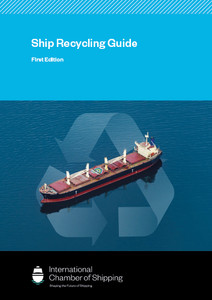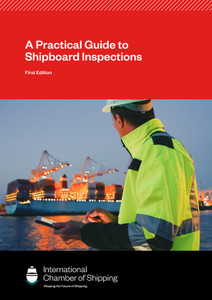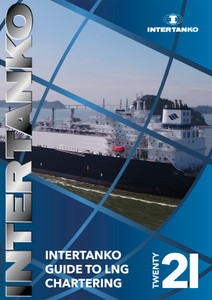
Underwater Radiated Noise Guide - First Edition
This ICS/BIMCO guide enables shipping companies to align with the IMO's 2023 underwater radiated noise guidelines and help preserve marine life. It explains:
- Sources of underwater radiated noise from ships
- The strong synergies between underwater radiated noise reduction and energy efficiency and the opportunities for co-benefit
- Design and operational measures that are likely to reduce noise levels
- How to develop a noise management plan and put it into practice
An example of a noise management plan is provided for shipowners to use as a functional template. Technical superintendents will find the included operational measures and in-depth discussion on the synergies between energy efficiency and underwater radiated noise reduction particularly valuable. Key information on all known Particularly Sensitive Sea Areas (PSSAs) and their regional slow-down regulations are detailed to aid ship officers when passage planning.
Underwater radiated noise is acknowledged as a significant form of pollution because of its impact on marine life, where it can disrupt critical life functions such as their ability to communicate. The International Chamber of Shipping (ICS) and BIMCO developed the Underwater Radiated Noise Guide to enable shipping companies to reduce noise levels across their fleets. It explains:
- Sources of underwater radiated noise from ships
- The strong synergies between underwater radiated noise reduction and energy efficiency and the opportunities for co-benefit
- Design and operational measures that are likely to reduce noise levels
- How to develop a noise management plan and put it into practice
An example of a noise management plan is provided for shipowners to use as a functional template. Technical superintendents will find the included operational measures and in-depth discussion on the synergies between energy efficiency and underwater radiated noise reduction particularly valuable. Key information on all known Particularly Sensitive Sea Areas (PSSAs) and their regional slow-down regulations are detailed to aid ship officers when passage planning.
By following the recommendations in this ICS/BIMCO guide, shipping companies can demonstrate commitment to the IMO's 2023 revised Guidelines for the reduction of underwater noise from commercial shipping and help tackle this issue impacting our oceans.
In 2014, the International Maritime Organization (IMO) produced Guidelines for the reduction of underwater noise from commercial shipping to address adverse impacts on marine life, which was then revised in 2023 to set out the new methods available to designers, shipbuilders and ship operators to improve their noise reduction efforts.
ICS and BIMCO have produced this Guide to provide the shipping industry with practical actions to align with the IMO 2023 guidelines, reduce underwater radiated noise levels and protect the marine environment. The Underwater Radiated Noise Guide expands on the IMO guidelines, providing up-to-date guidance on:
- Sources of underwater radiated noise and its far-reaching impact on marine life;
- Scope of regional regulations and voluntary measures;
- Synergies between energy efficiency measures and underwater radiated noise reduction; and
- How to set up a noise management plan.
This first edition will help shipowners, technical superintendents and ship's officers understand what underwater radiated noise is and how they can help reduce it.
Chapter 1 Introduction
1 Introduction
1.1 What underwater noise is
1.1.1 Continuous noise
1.1.2 Impulsive noise
1.2 How underwater radiated noise is measured
1.3 IMO measures on underwater radiated noise
1.4 Global targets
1.5 Global trends in underwater radiated noise
Chapter 2 Summary of the IMO guidelines
2.1 The underwater radiated noise management plan
2.1.1 The simple noise management plan
2.1.2 The more detailed noise management plan
2.1.3 Targets
2.1.4 Developing the noise management plan
2.2 Baseline measurements or predictions of underwater radiated noise
2.3 Incentive schemes
2.3.1 The International Association of Ports and Harbors Environmental Ship Index scheme
2.3.2 The Green Award scheme
2.4 Class rules and standards
2.5 Voluntary certifications
2.5.1 Green Marine
Chapter 3 Regional regulations and voluntary measures
3.1 IMO measures
3.2 Conventions and agreements related to protecting the marine environment from noise pollution
3.2.1 Convention for the Protection of the Marine Environment of the North-East Atlantic
3.2.2 Helsinki Commission
3.2.3 The Convention for the Protection of the Mediterranean Sea Against Pollution
3.2.4 The Marine Strategy Framework Directive
3.3 Mandatory measures
3.3.1 Gulf of St. Lawrence
3.3.2 United States North East
3.3.3 United States Mid-Atlantic
3.3.4 Great Barrier Reef
3.4 Voluntary measures
3.4.1 Sea ice covered areas and Inuit Nunaat
3.4.2 Port of Vancouver Enhancing Cetacean Habitat and Observation (ECHO) Programme
3.4.3 Northern and Central California Coast
3.4.4 Los Angeles
3.4.5 San Diego
3.4.6 Ports of Busan, Uslan, Yeosu, Gwangyang and Incheon
3.4.7 North-Western Mediterranean Sea
Chapter 4 Measures to reduce underwater radiated noise
4.1 The synergy between energy efficiency measures and reduction of underwater radiated noise
4.2 Energy efficiency measures to avoid or carefully manage
4.2.1 Optimisation of the propeller blade area ratio with consideration to ship wake
4.2.2 Slow running of ships fitted with controllable pitched propellers
4.2.3 Biofouling
4.3 The energy efficiency measures likely to simultaneously produce energy efficiency gains and reduce underwater radiated noise
4.3.1 Ship speed
4.3.2 Propeller improvements
4.4 Maintenance
4.4.1 Propeller maintenance
4.4.2 Hull maintenance
4.4.3 Machinery maintenance
4.5 Operational approaches
4.5.1 Voyage planning
4.5.2 Trim
4.5.3 Ship handling
4.6 Other measures
Appendices
Appendix A Example of a simple noise management plan
Appendix B Example of a ship noise measurement report
Appendix C Underwater radiated noise and GHG reduction potential of available solutions
Appendix D Checklist of operational measures to reduce underwater radiated noise
Appendix E IMO Revised guidelines for the reduction of underwater radiated noise
Appendix F References
ICS
The International Chamber of Shipping (ICS) is the principal international trade association for the shipping industry, representing shipowners and operators in all sectors and trades.
ICS membership comprises national shipowners' associations in Asia, Europe and the Americas whose member shipping companies operate over 80% of the world's merchant tonnage.
Established in 1921, ICS is concerned with all technical, legal, employment affairs and policy issues that may affect international shipping.
ICS represents shipowners with the various intergovernmental regulatory bodies that impact on shipping, including the International Maritime Organization.
ICS also develops best practices and guidance, including a wide range of publications and free resources that are used by ship operators globally.
https://www.ics-shipping.org/about-ics/about-ics
BIMCO
BIMCO is the world's largest direct-membership organisation for shipowners, charterers, shipbrokers and agents. In total, around 60% of the world's merchant fleet is a BIMCO member, measured by tonnage (weight of the unloaded ships).
The organisation has NGO status and is based in Copenhagen, Denmark, with offices in Athens, Singapore and Shanghai.
With around 1900 member companies across 120 countries, from the largest shipowners in the world to small local port agents and law firms, BIMCO represents a wide range of maritime companies and organisations.
BIMCO's goal is to secure a level playing field for the global shipping industry. BIMCO therefore works to promote and secure global standards and regulations for the maritime sector. The organisation's century long effort into creating standard contracts and clauses is an expression of that aim.
- Number of Pages:
- 142
- Book Height:
- 210 mm
- Book Width:
- 197 mm
- Publication Date:
- October 2024
- Author:
ICS and BIMCO
- Published Date:
- October 2024





